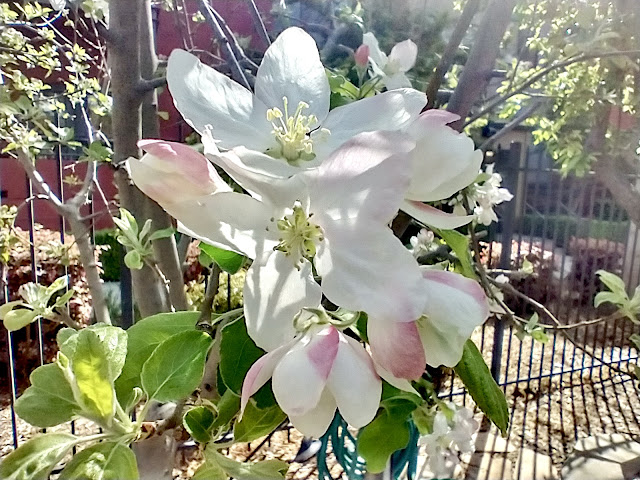
Spring starts with four days in the 80s

|
| It's apple blossom time -- and time to feed flowering trees and shrubs. (Photo: Debbie Arrington) |
Spring arrives Sunday, followed by what looks like a record heat wave.
According to the National Weather Service, Sacramento can expect four days in the 80s, starting Tuesday. This May-like weather peaks at 85 degrees on Wednesday, which would be a record for that date. The all-time hottest March day in Sacramento: 88 degrees.
This spike is 20 degrees higher than Sacramento’s average for mid-March – 65 degrees. Overnight lows (50-53 degrees) are also considerably higher than normal (44 degrees). Those two trends may warm soil up enough to start planting tomatoes – but not quite yet.
A cooldown to more-normal March temperatures is expected next weekend. Hopefully, more rain will follow.
As of noon, Saturday’s storm was less than spectacular. Although there were lots of clouds, rain wasn’t hitting the ground. The weather service lowered its rain estimate to 0.10 inches for most of Sacramento.
“Radar looks more impressive than reality,” the Sacramento NWS office tweeted Saturday morning. “Dry air has largely prevented rain from making it to the Valley surface (virga); only a trace of rain reported at Sac Exec & Int'l (airports). Chance of showers & even a rumble of thunder will be possible for the Valley through sunset.”
Check your soil moisture to see if your garden got the rain it needed. If not, give everything a deep soaking to prepare your plants for the heat ahead.
* Fertilize roses, annual flowers and berries as spring growth appears. Always water before fertilizing.
* Look out for aphids. Blast them off plants with a stream of water.
* Pull weeds now! Don’t let them get started. Take a hoe and whack them as soon as they sprout.
* Prepare summer vegetable beds. Spade in compost and other amendments.
* Prune and fertilize spring-flowering shrubs after bloom. Try using well-composted manure, spread 1-inch thick under the tree. This serves as both fertilizer and mulch, retaining moisture while cutting down on weeds.
* Feed camellias at the end of their bloom cycle. Pick up browned and fallen flowers to help corral blossom blight.
* Feed citrus trees as they start to bloom.
* Cut back and fertilize perennial herbs to encourage new growth.
* Seed and renovate the lawn.
* In the vegetable garden, transplant lettuce and cole family plants, such as broccoli, collards and kale.
* Seed chard and beets directly into the ground. (Beet seeds benefit from soaking first.)
* Plant summer bulbs, including gladiolus, tuberous begonias and callas. Also plant dahlia tubers.
Comments
0 comments have been posted.Sacramento Digs Gardening to your inbox.
Sites We Like
Garden Checklist for week of May 5
Survey your garden after the May 4 rainstorm. Heavy rain and gusty winds can break the neck of large flowers such as roses. Also:
* Keep an eye on new transplants or seedlings; they could take a pounding from the rain.
* Watch out for powdery mildew. Warmth following moist conditions can cause this fungal disease to “bloom,” too. If you see a leaf that looks like it’s dusted with powdered sugar, snip it off.
* After the storm, start setting out tomato transplants, but wait on the peppers and eggplants (they want warmer nights). Pinch off any flowers on new transplants to make them concentrate on establishing roots instead of setting premature fruit.
* Trim dead flowers but not leaves from spring-flowering bulbs such as daffodils and tulips. Those leaves gather energy to create next year's flowers. Also, give the bulbs a fertilizer boost after bloom.
* Pinch chrysanthemums back to 12 inches for fall flowers. Cut old stems to the ground.
* Mulch around plants to conserve moisture and control weeds.
* From seed, plant beans, beets, cantaloupes, carrots, corn, cucumbers, melons, pumpkins, radishes and squash.
* Plant onion sets.
* In the flower garden, plant seeds for asters, cosmos, celosia, marigolds, salvia, sunflowers and zinnias. Transplant petunias, zinnias, geraniums and other summer bloomers.
* Plant perennials and dahlia tubers for summer bloom.
* Don’t wait; plant summer bulbs, such as gladiolus and tuberous begonias.
* Harvest cabbage, lettuce, peas and green onions.